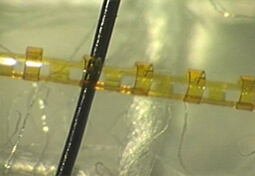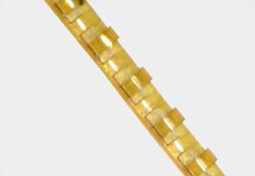When the results of this study are compared to the results of prior long-term studies of Canaloplasty glaucoma surgery, use of the Stegmann Canal Expander® appears to provide an additional 3mmHg of IOP lowering effect.2
Source: Canal Expander | Canal Expander [Internet]. Canalexpander.com. 2017 [cited 2017 Mar 18]. Available from: http://www.canalexpander.com/canal-expander/
Comparison to Trabeculectomy
One of the main arguments made against Canaloplasty is that it cannot (on its own, without eye medications) achieve an IOP reduction into the “low-teens”. This study directly addresses that concern. The IOP after Canaloplasty with the Stegmann Canal Expander® was noted to be ~13mmHg (”low-teens”) at every measured time point from six-months to two-years after surgery. Additionally, the final average number of medications required for IOP control after this glaucoma surgery was essentially none (0.2).
How does the “gold standard” of trabeculectomy compare?
Although there is yet no direct comparison between Canaloplasty with the Stegmann Canal Expander® and trabeculectomy, there are multiple studies assessing the IOP lowering benefit of trabeculectomy. One of the most respected of these is the Tube versus Trabeculectomy (TVT) study.3 In that study patients who underwent trabeculectomy experienced an average IOP of 12.1mmHg and were using an average of just under one (0.8) eye medication two years after surgery.
It appears that Canaloplasty with the Stegmann Canal Expander® is as effective as trabeculectomy at lowering IOP.
Where the similarities end, however, is with regard to risks of surgery. As discussed in detail elsewhere, trabeculectomy is associated with many risks, a number of them can even result in loss of vision.
Thus, Canaloplasty with the Stegmann Canal Expander® may be as effective as trabeculectomy but with far fewer risks to the individual with glaucoma.
Don’t delay getting checked for glaucoma. Make an appointment with an eye doctor in your area now. If you live in the greater Los Angeles area and would like Dr. David Richardson to evaluate your eyes for glaucoma call 626-289-7856 now. Same day or next day appointments are available Tuesday through Saturday.
In The Same Series:
- Canaloplasty with the Stegmann Canal Expander®
- How Well Does the Stegmann Canal Expander® Work?
- Risks of Canaloplasty with the Stegmann Canal Expander®
- Comparison to Canaloplasty without the Stegmann Canal Expander®
- Who Will Likely Benefit from the Stegmann Canal Expander®?
Related Articles:

David Richardson, MD
Medical Director, San Marino Eye
David Richardson, M.D. is recognized as one of the top cataract and glaucoma surgeons in the US and is among an elite group of glaucoma surgeons in the country performing the highly specialized canaloplasty procedure. Morever, Dr. Richardson is one of only a few surgeons in the greater Los Angeles area that performs MicroPulse P3™ "Cyclophotocoagulation" (MP3) glaucoma laser surgery. Dr. Richardson graduated Magna Cum Laude from the University of Southern California and earned his Medical Degree from Harvard Medical School. He completed his ophthalmology residency at the LAC+USC Medical Center/ Doheny Eye Institute. Dr. Richardson is also an Ambassador of Glaucoma Research Foundation.




